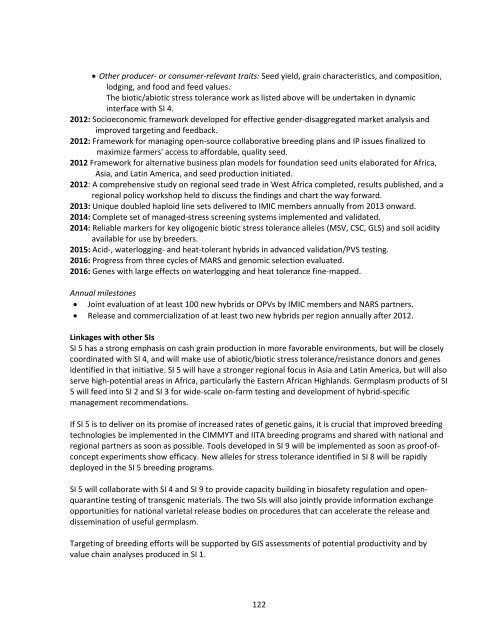Download - Maize
Download - Maize
Download - Maize
You also want an ePaper? Increase the reach of your titles
YUMPU automatically turns print PDFs into web optimized ePapers that Google loves.
Other producer‐ or consumer‐relevant traits: Seed yield, grain characteristics, and composition,<br />
lodging, and food and feed values.<br />
The biotic/abiotic stress tolerance work as listed above will be undertaken in dynamic<br />
interface with SI 4.<br />
2012: Socioeconomic framework developed for effective gender‐disaggregated market analysis and<br />
improved targeting and feedback.<br />
2012: Framework for managing open‐source collaborative breeding plans and IP issues finalized to<br />
maximize farmers' access to affordable, quality seed.<br />
2012 Framework for alternative business plan models for foundation seed units elaborated for Africa,<br />
Asia, and Latin America, and seed production initiated.<br />
2012: A comprehensive study on regional seed trade in West Africa completed, results published, and a<br />
regional policy workshop held to discuss the findings and chart the way forward.<br />
2013: Unique doubled haploid line sets delivered to IMIC members annually from 2013 onward.<br />
2014: Complete set of managed‐stress screening systems implemented and validated.<br />
2014: Reliable markers for key oligogenic biotic stress tolerance alleles (MSV, CSC, GLS) and soil acidity<br />
available for use by breeders.<br />
2015: Acid‐, waterlogging‐ and heat‐tolerant hybrids in advanced validation/PVS testing.<br />
2016: Progress from three cycles of MARS and genomic selection evaluated.<br />
2016: Genes with large effects on waterlogging and heat tolerance fine‐mapped.<br />
Annual milestones<br />
Joint evaluation of at least 100 new hybrids or OPVs by IMIC members and NARS partners.<br />
Release and commercialization of at least two new hybrids per region annually after 2012.<br />
Linkages with other SIs<br />
SI 5 has a strong emphasis on cash grain production in more favorable environments, but will be closely<br />
coordinated with SI 4, and will make use of abiotic/biotic stress tolerance/resistance donors and genes<br />
identified in that initiative. SI 5 will have a stronger regional focus in Asia and Latin America, but will also<br />
serve high‐potential areas in Africa, particularly the Eastern African Highlands. Germplasm products of SI<br />
5 will feed into SI 2 and SI 3 for wide‐scale on‐farm testing and development of hybrid‐specific<br />
management recommendations.<br />
If SI 5 is to deliver on its promise of increased rates of genetic gains, it is crucial that improved breeding<br />
technologies be implemented in the CIMMYT and IITA breeding programs and shared with national and<br />
regional partners as soon as possible. Tools developed in SI 9 will be implemented as soon as proof‐ofconcept<br />
experiments show efficacy. New alleles for stress tolerance identified in SI 8 will be rapidly<br />
deployed in the SI 5 breeding programs.<br />
SI 5 will collaborate with SI 4 and SI 9 to provide capacity building in biosafety regulation and openquarantine<br />
testing of transgenic materials. The two SIs will also jointly provide information exchange<br />
opportunities for national varietal release bodies on procedures that can accelerate the release and<br />
dissemination of useful germplasm.<br />
Targeting of breeding efforts will be supported by GIS assessments of potential productivity and by<br />
value chain analyses produced in SI 1.<br />
122

















